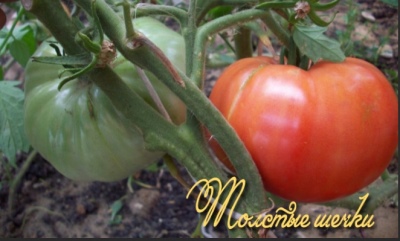
- Authors: Kachainik V.G., Gulkin M.N., Karmanova O.A., Matyunina S.V. (Agrofirma Aelita LLC)
- Year of approval: 2015
- Category: grade
- Growth type: indeterminate
- Appointment: fresh consumption, for juice, for ketchup and tomato paste
- Ripening period: mid-season
- Ripening time, days: 115-120
- Growing conditions: for open ground, for film greenhouses
- Marketability: high
- Bush size: tall
Inexperienced gardeners, as well as farmers who grow tomatoes in large volumes, will certainly be interested in varieties with simple agricultural technology and high yield rates. These types include the mid-season tomato variety Thick cheeks.
Breeding history
Tomato Thick Cheeks was created by a group of breeders of the agricultural company "Aelita" (S. V. Matyunina, O. A. Karmanova, V. G. Kachainik and M. N. Gulkin) less than 10 years ago. The nightshade crop appeared in the list of breeding achievements of the Russian Federation in 2015. In the same period, the tomato was approved for use. Such a plant is recommended for all regions of the Russian Federation. The tomato grows well and bears fruit both in protected grounds and in garden beds.
Description of the variety
The thick-cheeked tomato is a tall plant reaching 170-200 cm in height. The indeterminate bush is characterized by abundant foliage, a powerful erect central stem with an edge, moderate branching, a developed rhizome and intermediate inflorescences. 7-8 fruit clusters with 4-6 berries on each grow on the bush.
When growing, it is necessary not only to care for the plant, but also to form bushes in 1-2 stems, remove unnecessary stepsons and be sure to tie the culture to strong supports. In addition, the dark green leaves on the bushes should be thinned regularly so that they do not take vital energy from the plant. This tomato has a universal purpose, for which many housewives appreciate it. Tomatoes are eaten fresh and also used for harvesting.
The main qualities of the fruit
Thick cheeks belong to the class of large-fruited varieties. On average, the mass of one tomato can be 450 grams, and in greenhouse conditions the tomatoes will be even more - 600-800 g. The shape of the vegetable is flat-round, with an average ribbing surface. Ripe tomato is evenly covered with a rich red color. When unripe, tomatoes have a light green color with a dark dot at the stalk. The berry peel is easy to remove, it is dense, elastic, well preventing cracking. Vegetables tolerate transportation well and can be stored for a long time without losing their taste and marketability.
Taste characteristics
The taste of the fruit is delicious. The flesh of the vegetable is quite dense, differs in fleshiness. There are a lot of seeds, but they are practically not felt. The taste of tomato is dominated by pronounced sweetness, diluted with a barely noticeable sourness. The pulp contains 4.5-5% sugars. The aroma is classic, spicy, like most tomato varieties. With improper watering during cultivation, the tomato can acquire a bright sourness that will dominate the taste.
Ripening and fruiting
The vegetable belongs to the mid-season types of tomatoes. From the emergence of sprouts to the ripening of tomatoes, 4 months pass - 115-120 days. The crop yields are extended. Harvesting is carried out from July to September.
Yield
The yield of this tomato species is one of its advantages. Observing all agrotechnical recommendations, you can grow from 9 to 10 kg of ripe vegetables on a square of soil. A single bush can produce 4-4.5 kg of berries.
The timing of planting seedlings and planting in the ground
It is possible to sow material for seedlings from the 15th of March, 60 days before transplanting the bushes to the garden.The seeds are pre-sorted, disinfected in a solution of potassium permanganate, treated with growth stimulants. Seed germination will accelerate the greenhouse effect (use of glass or polyethylene). As a rule, the mass germination of shoots begins on the 6-8th day. With the appearance of 2-3 leaves, seating can be carried out in separate cups. Many experts recommend starting hardening the bushes 10-15 days before transplanting, which will simplify the adaptation of plants to a new place.
You can transplant seedlings in late May-early June, when the air and soil are well warmed up.

Growing tomato seedlings is an extremely important process, because it largely depends on whether the gardener will be able to harvest at all. All aspects must be taken into account, from seedbed preparation to planting in the ground.
Landing scheme
The way the tomatoes are arranged in the garden is no less important than the observance of agricultural technology. When planting, it is recommended to plant 4-6 bushes per 1 m2. The optimal layout for planting is considered to be 60x50 cm.

Growing and care
The plant is planted in two ways, but the seedling will be optimal. The tomato prefers loose, breathable and fertile soil. The best is the area where zucchini, parsley and cauliflower used to grow. Tomatoes love when the area is well lit by the sun.
In addition to the right place for growing, tomatoes need to be provided with comprehensive care, consisting of watering, fertilizing, forming and tying bushes, weeding and loosening the soil, pinching, thinning foliage, protection from insects and fungus. When growing in greenhouses, be aware of the daily ventilation required to control humidity.




A plant needs different micronutrients at each stage of growth. All fertilizers can be divided into two groups: mineral and organic. Folk remedies are often used: iodine, yeast, bird droppings, eggshells.
It is important to observe the rate and period of feeding. This also applies to folk remedies and organic fertilizers.
Disease and pest resistance
The plant has excellent immunity to many ailments. The tomato does not undergo verticillium, fusarium wilt and tobacco mosaic virus. Preventive treatment with a copper-containing preparation will protect against late blight.
Resistant to adverse conditions
The excellent stress tolerance of tomatoes helps them easily tolerate sudden drops in temperature, short drought and heat.



























































































